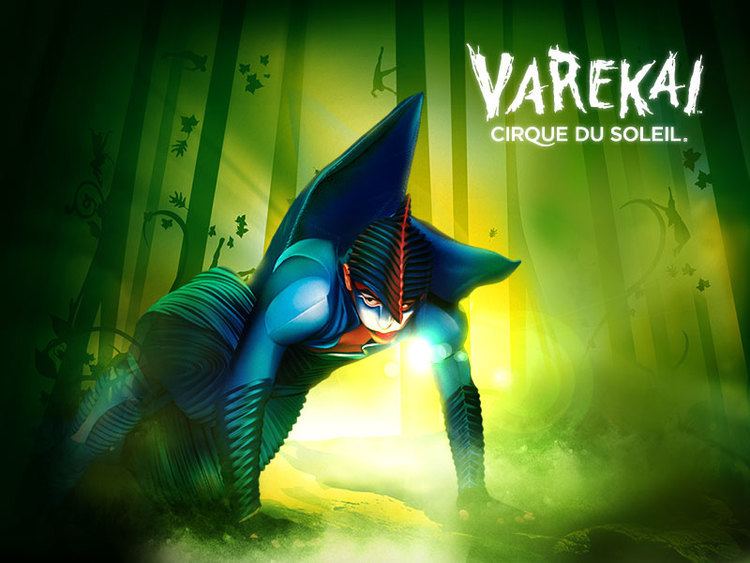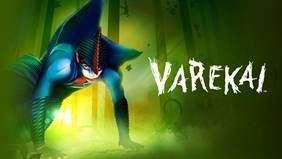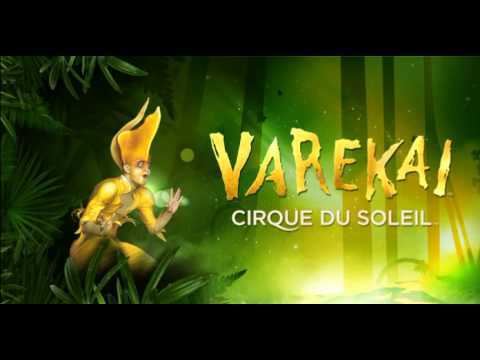Director Dominic Champagne Set designer Stéphane Roy | Show type Touring show Director of creation Andrew Watson | |
Date of premiere April 24, 2002 (Montreal) Similar Love, Luzia, Paramour, Spring Awakening | ||
Varekai back stage
Varekai is a Cirque du Soleil touring production that premiered in Montréal in April 2002. Its title means "wherever" in the Romani language, and the show is an "acrobatic tribute to the nomadic soul".
Contents
- Varekai back stage
- Varekai mannequin challenge by cirque du soleil
- Set and technical information
- Cast and crew
- Acts
- Retired Acts
- Costumes
- Music
- Album
- Vocalists
- Filmography
- Tour
- References

The show begins with the Greek myth of Icarus, picking up where the myth leaves off, reimagining the story of what happened to Icarus after he flew too close to the sun and fell from the sky. In Varekai, rather than drowning in the sea below him, Icarus lands in a lush forest full of exotic creatures.

Varekai mannequin challenge by cirque du soleil
Set and technical information

The set, created by Stéphane Roy, includes four major components: the forest, stage, catwalk, and lookout. The forest consists of 330 "trees", of which around 20 are climbable. The trees range from 4.5 metres (15 ft) to 10.5 metres (34 ft) in height. The stage is 12.8 metres (42 ft) in diameter and has five trap doors, two turntables, and one elevating platform. The catwalk is 30 metres (98 ft) in length and allows performers to cross over the stage; it ends at a lookout which is 7 square metres (75 sq ft).
Cast and crew

Approximately 95 people travel with the Varekai tour; 50 are artists and the rest are crew. During each engagement in a city, anywhere from 80 - 100 people are hired locally for temporary jobs during the week but mainly for load-in and load-out. The cast and crew is an international one, representing 19 nationalities.
Acts
Retired Acts
Costumes
Varekai's costume designer, Eiko Ishioka, set out to design the costumes to heighten the sense of risk and danger the artists face while performing their acts. The designs are an approach to give the traditional leotard a new shape. Eiko drew inspiration from the natural world: plant life, reptiles, land animals, marine life, wind, water, fire and wood. While there are over 130 costumes in the entire collection, over 600 elements combine to make the entire wardrobe of costumes, shoes, hats, and accessories. During the tour it takes a 250 hours a week to keep the costumes in a state usable for performance. This includes repairs, cleaning, pressing, repainting (shoes), ironing, and other related tasks.
One of the primary materials used throughout the wardrobe is lycra, primarily for its ease of care, suppleness, and elasticity. Other materials used throughout include titanium rods, nylon sponge and other types of fire-retardant materials. La Toupie's costume, for example, is made from lycra, and the tentacles are made from polystyrene foam. In addition to textures and structures being created for the costumes, digital screen-printing was utilized for some pieces. The costumes for the Russian swing act were inspired by volcanic eruptions. Pictures were taken, scanned, processed and then digitally screen-printed to give the characters their bright red, explosive appearance. The foliage seen on the heads and backs of some characters is made from crinyl and cristalette, which are both extremely light-weight materials. Some of the translucent carapaces seen on some performers, including La Promise, are made from stretch netting mounted on a structure made of boning.
Music
The live music is performed by seven musicians and two singers. Composed by Violaine Corradi and directed by the bandleader/keyboard player, the music features many different genres and energies. Violaine combined the sounds of Hawaiian rituals, 11th-century French troubadour songs, traditional Armenian melodies and gospel music with contemporary arrangements to create the sound of Varekai. While some songs are quiet and sorrowful, others are more upbeat and exciting.
The only remaining original cast/crew member, in addition to having performed in every one of Varekai's 5,000 shows (and counting) without missing a single performance, is drummer Paul James Bannerman Drummer's Official Site.
Instruments used in the show include keyboards, bass, drums, percussion, violin, and various wind instruments. There are numerous instrumental solos, with the violin, flute, and accordion among the instruments heard. When these occur, the musician comes into view, still hidden in the trees but slightly visible to the audience.
There are two distinct voices in the musical score. Their role is to link the story together, sometimes predicting the future, at other times, propelling the story forward. The female singer called "The Muse " (currently played by Isabelle Corradi) and the male singer called the "Patriarch " (currently played by Craig Jennings) each share the songs alternating between solos with harmonies and duos. The Muse, dressed in white & purple and The Patriarch, dressed in purple and black emerge from the forest throughout the show.
Album
Returning from her work with Cirque du Soleil's Dralion, Violaine Corradi wrote the Varekai score, which was released as a CD album on January 7, 2003. Rather than creating a literal soundtrack, Cirque du Soleil collaborated with Nitin Sawhney to produce a CD with themes and sounds from Varekai but quite differently arranged. The CD features the vocals of the two original singers of Varekai, Zara Tellander and Mathieu Lavoie; the soundtrack also includes the vocals of world music artists Natacha Atlas and Tina Grace, who were not in the production, simply featured on the album. Many of the CD tracks are dramatically different from their live counterparts.
In late 2003 Cirque du Soleil created an 'Exclusive Premium Edition' CD, which featured the original CD as well as a bonus CD and DVD containing 6 live tracks, two remixes, and 2 music videos.
Track listing:
- Aureus (Spoken Word, 2002 - Present)
- Rain One (Interlude, 2002 - Present)
- Le Rêveur (Solo on Crutches, 2002 - Present)
- Vocea (Flight of Icarus, 2002 - Present)
- Moon Licht (Handbalancing on Canes, 2002 - Present)
- Rubeus (Spoken Word, 2002 - Present)
- Patzivota (Setup to Russian Swing, 2002 - Present)
- El Péndulo (Aerial Straps, 2002 - Present)
- Gitans (Opening, 2002 - Present)
- Kèro Hiréyo
- Triple Trapeze (2002 - 2013)
- Aerial Hoop (2013)
- Dance Trapeze (2014 - Present)
- Infinitus (Spoken Word, 2002 - Present)
- Lubia Dobarstan
- Water Meteors (2002 - 2013)
- Sticks (Rotation, 2014 - Present)
- Emballa (Juggling, 2002 - Present)
- Oscillum (Russian Swing, 2002 - Present)
- Funambul (Cloud Interlude, 2002 - Present)
- Resolution (Not in Show)
Below are the live tracks, in order as they appear on the Exclusive Premium Edition bonus CD. Listed after each track title is the act associated with the track.
- Célébration de l'Errance (Opening Dance and Finale, 2002 - Present)
- Trasparenza
- Acrobatic Pas de Deux (2002 - 2003)
- Aerial Hoop (Rotation, 2004 - 2013)
- Euphoria
- Icarian Games (2002 - 2015)
- Synchronized Tumbling (2015 - Present)
- Sun Drum Fun (Body Skating, 2002 - Present)
- Mutationis (Handbalancing on Canes, 2002 - Present)
- Movimento (Georgian Dance, 2002 - Present)
The bonus CD also contains two tracks that are remixed versions of "El Péndulo" and "Emballa". In addition, the DVD features two videos with nature and recording footage, set to the CD version of "Patzivota" and "Moon Licht".
Vocalists
Here is a list of all of the singers in Varekai, since its premiere in 2002.
Female Singers
Male Singers
Filmography
The experiences of the initial cast during the creation of the show were portrayed in the television series Cirque du Soleil: Fire Within (featured on the Bravo Network). Fire Within won the 2003 Emmy Award in the "Outstanding Non-Fiction Program" (Alternative) category.
Cirque du Soleil released a film adaptation of Varekai on June 14, 2003, directed by Dominic Champagne and Nick Morris. The filming took place in Toronto during the show's tour and the vocalists in the filming were Zara Tellander and Mathieu Lavoie with Anton Tchelnokov as Icarus, Olga Pikhienko as La Promise/The Betrothed and John Gilkey as The Skywatcher.
Tour
Varekai completed its first North American tour in Vancouver, Canada on July 23, 2006. It debuted in Australia in August 2006 and arrived in New Zealand in early 2007. Later that year, Varekai finished its Australian tour in Perth, and moved on to its first European tour. At the end of 2007 the show had its European premiere in Antwerp, Belgium. It had its UK premiere in 2008 at London's Royal Albert Hall and again on 5 January 2010, marking the 25th anniversary of Cirque du Soleil.
Following the European tour that cumulated in Barcelona as 2010 came to a close, the show toured to Taipei, Taiwan; Seoul, South Korea and Manila, Philippines in 2011. The Manila run was exceptional in that the show endured the monsoon season and several typhoons.
In the later half of 2011 Varekai landed in São Paulo and spent twelve months in Brazil before continuing to Argentina and Chile in 2013, and then Peru, Colombia, Costa Rica and Mexico in 2013. Guadalajara, followed by Mexico City were the final destinations for the Grand Chapiteau. Varekai performed the last performance under the Grand Chapiteau on November 24, 2013.
The show then transferred to the Arena format in late 2013. The city that hosted the transformation was Bossier City, Louisiana, seen in public for the first time on December 12, 2013. After the transformation in Bossier City, Varekai played the Arena version at Centre Bell in Montreal just before Christmas in 2013, honouring the long-standing Cirque tradition of a winter show at the Centre Bell.
Varekai has been seen by more than 6 million spectators around the world, and has reached many milestones to accomplish this.
Varekai has been to many different regions, here is the list of all of them.
Since Varekai's premiere in 2002, it has had an extensive touring history, as detailed below.
The following colorboxes indicate the region of each performance: EU Europe NA North America SA South and Central America AP Asia/Pacific OC Oceania AF Africa
